Obstinate to the last, his own wavelength, radio signals from the dwarf planet Pluto, etc.
 Jeffrey Wells
Jeffrey Wells
Fine With Me
One less Trump-supporting billionaire…an odious, over-fed figure…a symbol of ruthless self-interest… unenlightened shadows cast…down through all eternity, the crying of humanity.
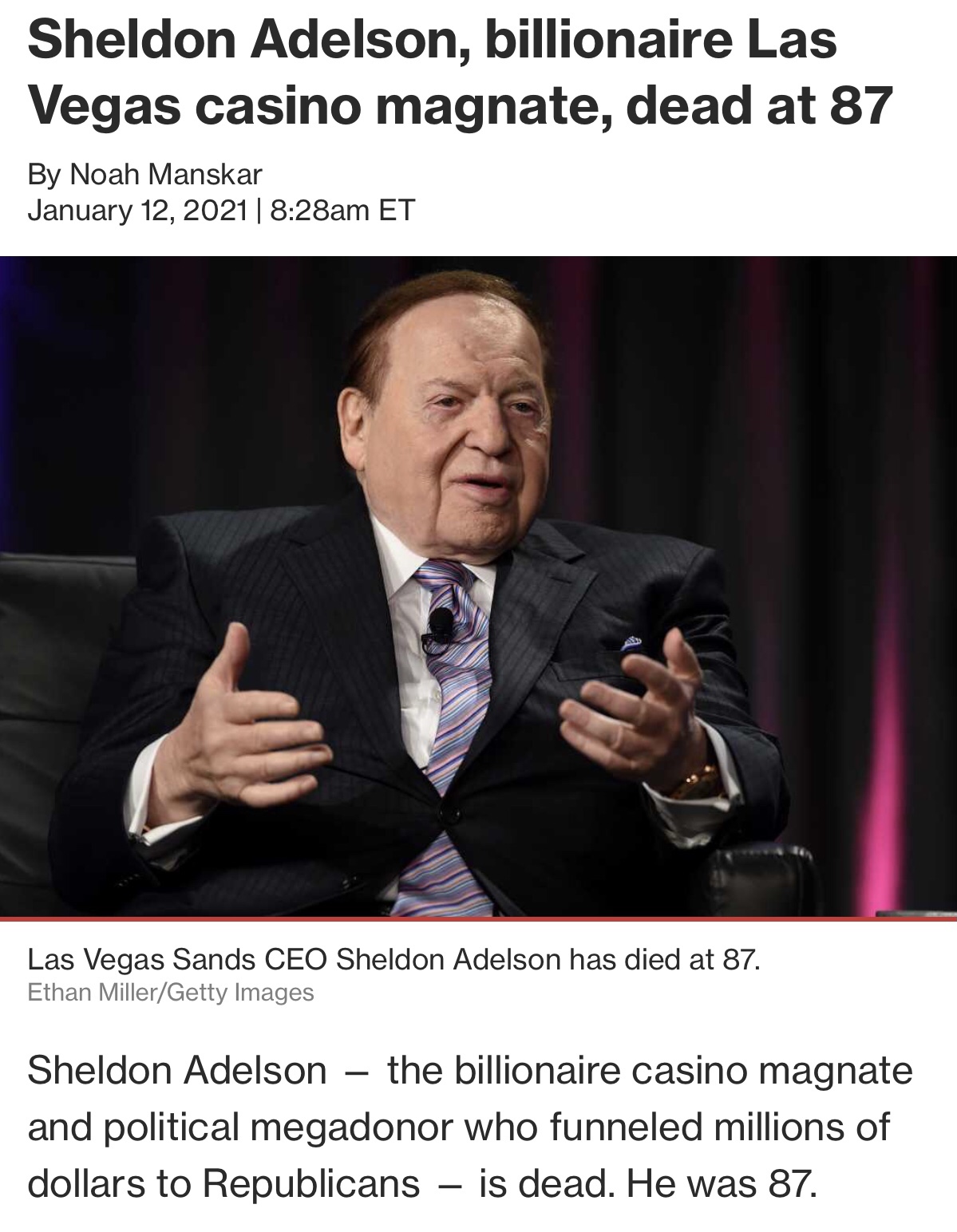
Unmistakably Awful
First, if I’ve explained this once I’ve explained it 25 times — lead protagonists are not allowed to suddenly wake up from a nightmare by sitting up wide-eyed and gasping. Jimmy Stewart‘s Scotty Ferguson did this 62 years ago in Vertigo, but it’s not permitted any more because it’s been DONE TO DEATH.
Second, Clarice Starling isn’t a celebrity — she’s just an FBI grunt who happened to play a key role in catching the infamous Buffalo Bill. News reports may have mentioned her role in the capture but she didn’t hire a publicist to hype her exploits because junior FBI agents don’t do that.
Third, it is therefore IDIOTIC for an older woman of authority to say to Starling, “You are a woman with a very public reputation…for hunting monsters.” No, she isn’t because she didn’t star in an Oscar-winning movie — she’s just a junior FBI agent who graduated from the FBI Academy a year or so ago. Nobody knows who she is — FBI agents don’t want publicity — they’re modest investigators and law enforcers.
The stupidity is staggering.
The Buckingham’s “Don’t You Care?”
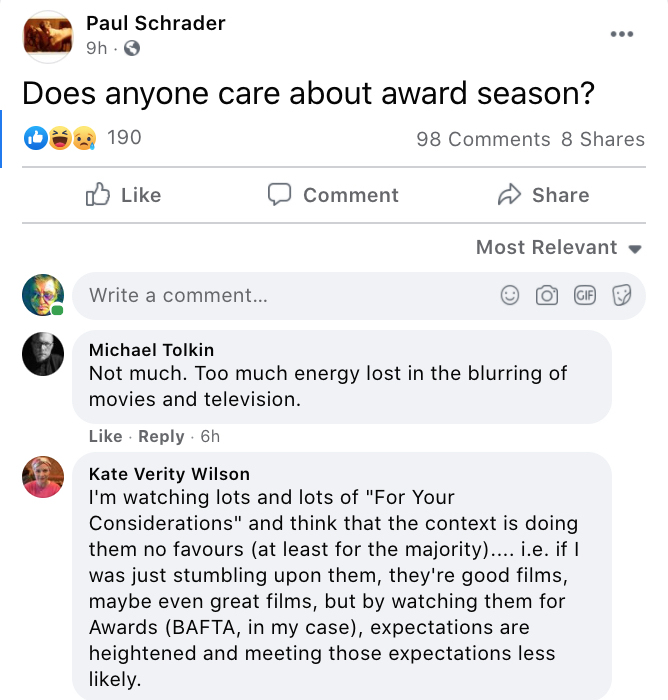
Easy Answer for Paul Schrader: It’s hard to gauge how much the Academy membership cares right now about the streaming pandemic Oscars, especially with the big telecast over three months away. What’s certain is that everyone is too afraid to vote with their gut about anything. There’s only one way to vote and that’s defensively. Here’s how Sasha Stone and HE have explained it in previous posts:
Stone explanation #1: “Bloggers scan each project for un-wokeness. Films by and about white males are mostly fair game for any kind of attack, and hopefully will eventually be just completely shunned. One tweet is all it takes to send a wave of hysteria through the hive mind and suddenly that film, too, is problematic. And anyone who likes the film or votes for the film is likewise caught up in that shitstorm.”
HE Explanation: “Twitter is the judge and jury but no one wants to be seen as complicit in anything outside the approved wokester safety zone, and so they vote accordingly.”
Stone explanation #2: “Bloggers and critics are therefore modulating for this potential blowback with [careful] choices. We’re all predicting the Oscar using the same method. In an ordinary year we might pick a movie [that] Oscar voters would likely go for, given what we know of the Academy’s taste. This year, we compensate for the ‘woke scare’ and we say ‘this is the movie they might go for if they are wanting to send a message that they are not racists or sexists or transphobes.’ In short, people will likely be voting from a place of defending themselves from potential attacks.”
Two Movies and a Play
It’s 12.9.47, the weather’s a bit nippy, and the city is tingling with pre-Christmas cheer. Imagine catching an early afternoon showing of Vittorio DeSica‘s Shoeshine at the Avenue Playhouse, and then a 4 pm screening of Jacques Tourneur‘s Out of the Past at the Palace. Then grabbing dinner at Lindy’s. And then making an 8:30 pm curtain for the just-opened A Streetcar Named Desire at the Barrymore on West 47th Street. Costarring Jessica Tandy, Kim Hunter and some young unknown guy whose performance the critics approved of but that’s all.
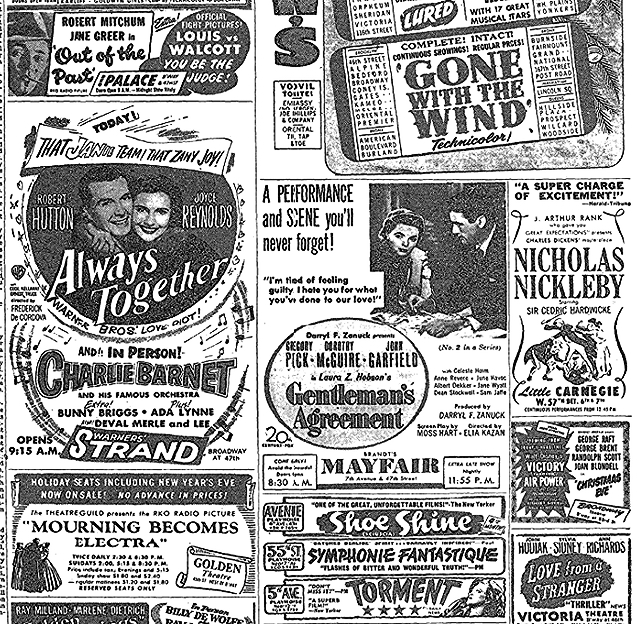

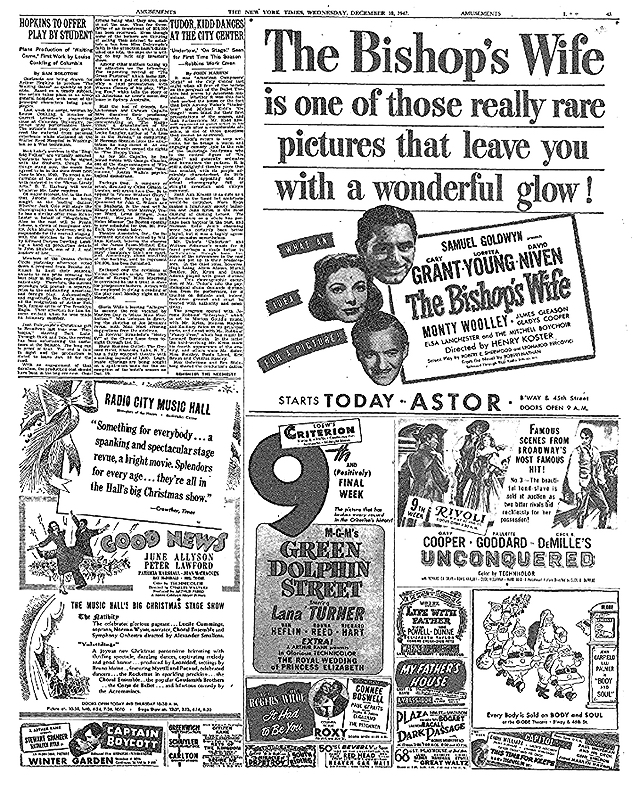
Billie Square
The trailer for The United States vs. Billie Holiday (Hulu 2.26) offers a glimpse of a rainy Times Square sometime in early 1948. Except the two most visible movie marquees are playing films that opened seven months apart — The Bishop’s Wife (12.9.47) and Key Largo (7.16.48).
Is it likely that The Bishop’s Wife was still playing at a first-run theatre in mid July ’48? No, not very — hit films could last several weeks in Times Square (or even longer if it was a big roadshow event film with reserved seats) but not seven months.
And look at that rainy noirscape — people are wearing hats and overcoats and Billie is draped in a white fur wrap. I know what mid-July is like in NYC — women don’t wear fur when they’re melting from the heat.
The bottom line is that this is a fantasy Times Square…let’s call it Billie Square. The Bishop’s Wife is playing at a big corner theatre that could have been the Roxy, except it opened at the Astor. Why couldn’t they just get it right?
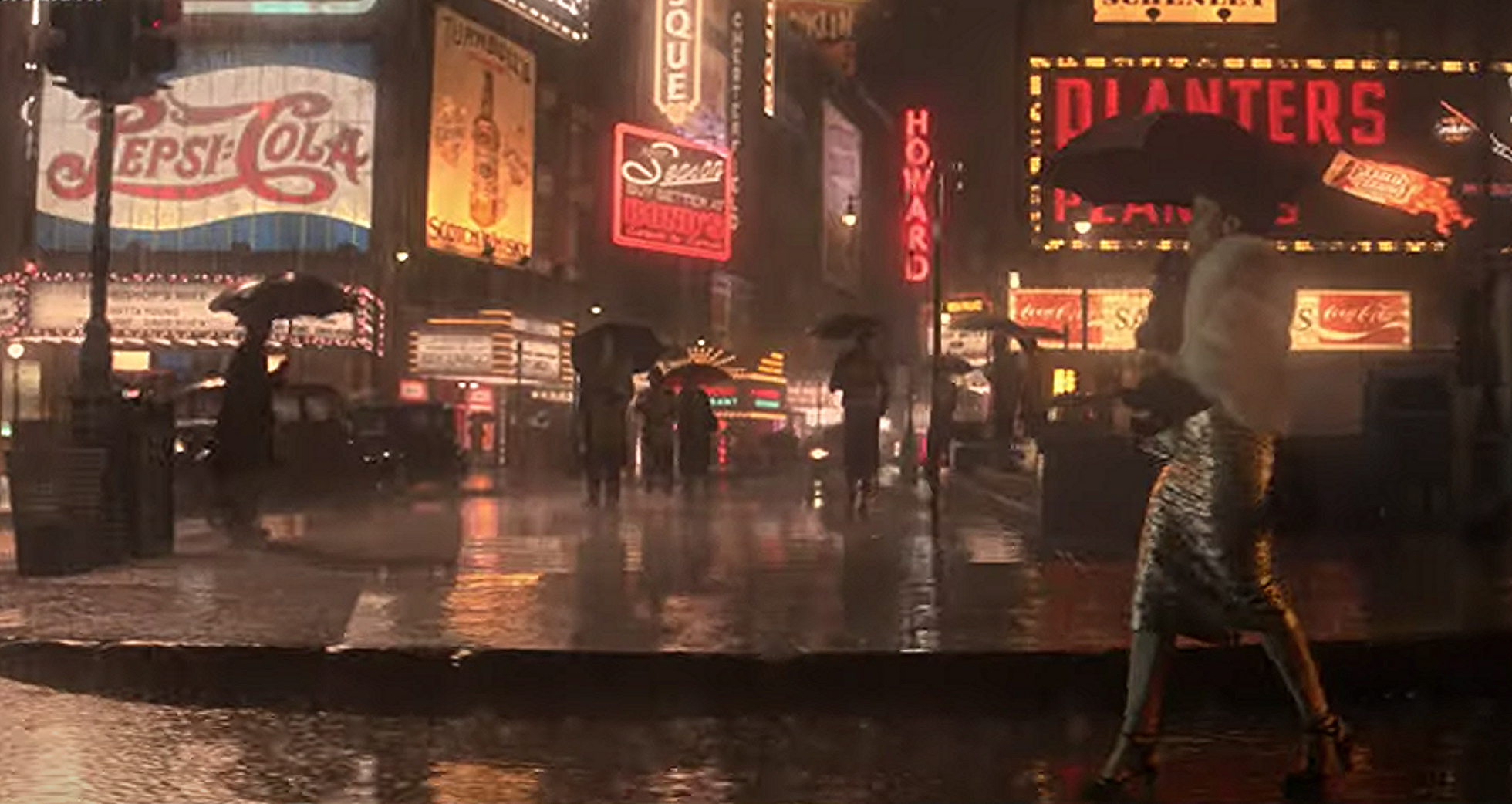
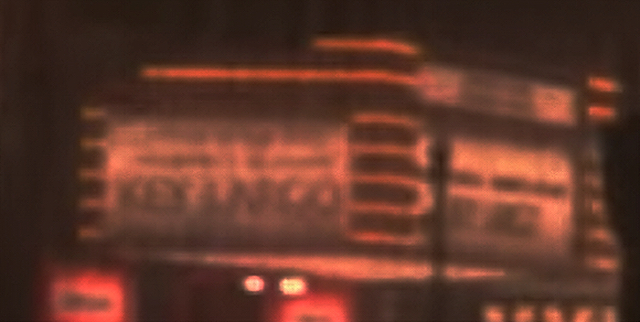
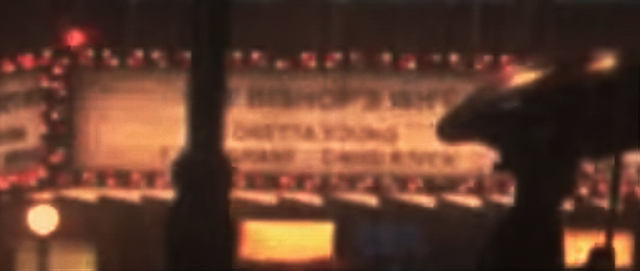
Persecution Was Their Game
Lee Daniels‘ The United States vs. Billie Holiday (Hulu, 2.26.21) seems to be a standard “evil white racist government fucktards make life miserable for a gifted, velvet-voice blues singer who should have been left alone” movie.
The source novel, Johann Hari‘s “Chasing the Scream” (2016), isn’t about Holiday as much as the war on drugs that began in the late ’40s, so obviously Daniels’ isn’t remaking Lady Sings The Blues (’72). Which I wouldn’t have minded.
I suspect that Daniels’ film is going to be celebrated mostly for Andra Day‘s lead performance. Two sources say the early word on the film itself is not auspicious.
Murdoch, Zuckerberg Are Chief Villains
Lincoln Project’s Rick Wilson (at 15:05): “And I will tell you there are two people who need to be held accountable if domestic [rightwing] terrorism continues to rise. Rupert Murdoch, whose network is the wellspring of [nearly] all the misinformation in the universe, and Mark Zuckerberg, whose platform amplifies it and tells Donald Trump supporters that there’s a conspiracy against them, that the 11.3.20 election [was] fake, that Joe Biden‘s election was illegitimate, and that violence is a political option. Those two people have a vast influence upon the political culture in this country cannot be over-estimated.
16:03: “Donald Trump’s life is about to become a burning hell, a misery of unparalleled scope. The New York attorney general is gonna go after him on tax fraud, bank fraud…he is never going to escape court for the rest of his life.”
Sequence Needed Two Cameras, Editing
It’s not that HE forgot to salute heroic Capitol Police officer Eugene Goodman, who managed to divert a crowd of “stop the steal” rioters from rushing into the Senate. I just didn’t see the heroism at first.
I saw a guy simultaneously (a) defying the hooligans and waving his baton and (b) backing away and running up the stairs. I watched it two or three times and said “okay, brave man but I don’t see the bold heroism.”
Only now that everyone is proclaiming Goodman a hero…only now am I finally understanding what happened. When he pushed one of the hillbillies in the chest, he was goading him and the crowd into following him down the hall in the opposite direction of the Senate chamber. Got it, took me a while. But didn’t the animals break into the Senate anyway? I saw the photos the day it happened.
If this encounter had been dramatized in a film directed by Alfonso Cuaron or David Fincher or Martin Scorsese, Goodman’s motive and strategy would have been much clearer. On top of which the sequence would have been shot horizontally instead of with the dreaded “portrait” (i.e., vertical) a.r., which a vast majority use time and again. All you have to do is tip the phone 90 degrees to the left…not hard.
Slim’s Story
Yesterday I read portions of the late Slim Keith’s 1990 autobiography “Slim,” or more precisely the chapters that cover her marriage to legendary director Howard Hawks.
According to Slim HWH was a generous provider but not much of a husband. He was emotionally brusque. Aloof to a fault. He was mainly focused on his career, carousing, motorcycles, hunting, horses, gambling and always the company of his hotshot Hollywood friends.
The Grey Fox was distant and rote in matters of intimacy (wham-bam). He apparently liked the “idea” of Slim more than who she actually was. HWH mainly valued her as the ultimate “Hawks woman” archetype — a frank manner, social elegance, sophistication, brains and arm-candy glamour.
He completely ignored their daughter Kitty when she came along, and never nurtured any kind of relationship as she grew up.
HWH was a total hound, Slim claims. By ‘45 she had told Ernest Hemingway or Leland Hayward (or both) that she couldn’t stand him.
Plus he wasn’t that much of a pilot or a sailor, she says. (Sea-sickness, air-sickness.). And Hawks always exaggerated his stories.
When the split finally happened he accepted that they didn’t have much rapport. Their marriage was basically a dead shark during the filming of Red River.
Hawks should have married someone less willful and independent. They just weren’t a match
I never knew that their Hog Canyon ranch home (in Bel Air?) was a close copy of the Connecticut country home in Bringing Up Baby. But I love that it was.
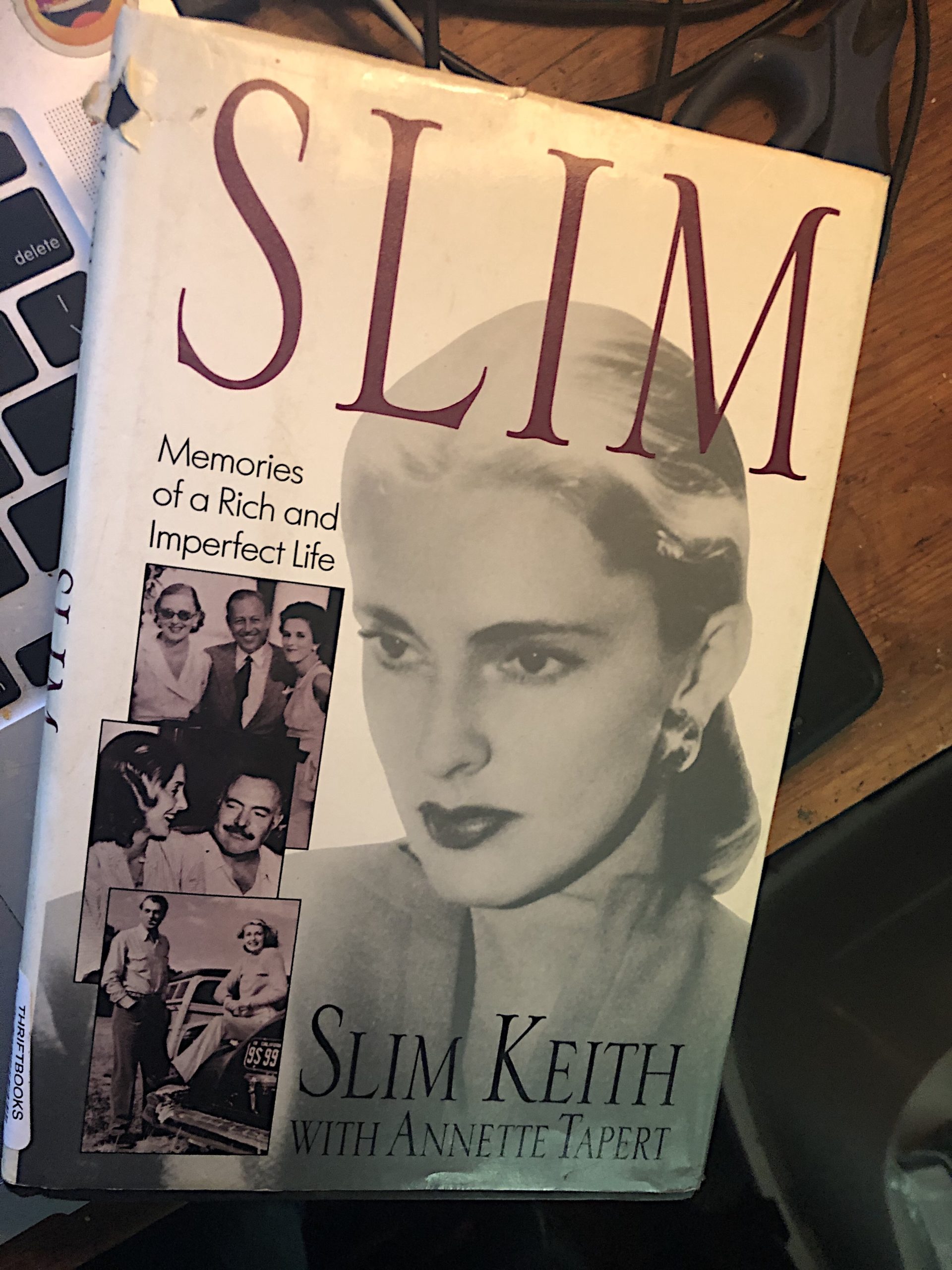
Peak Emotional Turbulence
I haven’t been offered the opportunity to see Sam Levinson‘s Malcom & Marie (Netflix, 2.5). Shot on 35mm black-and-white film, it says here…sold on this aspect alone. On the other hand the trailer feels simultaneously thin and exhausting. Then again it’s only a trailer.
Levinson wrote the screenplay in six days, and rested on the seventh. John David Washington and Zendaya costar, and no one else. Pic was shot inside the “Caterpillar House” in Carmel between 6.17 and 7.2.
Boilerplate: “A filmmaker (Washington) returns home with his girlfriend (Zendaya) following a celebratory movie premiere as he awaits imminent critical praise and financial opportunities galore. The unexpected happens as revelations about their relationships begin to surface, etc.”





